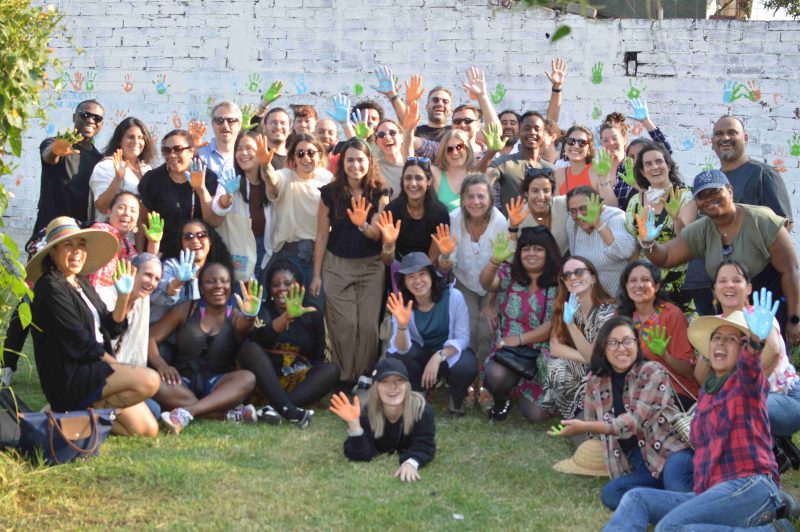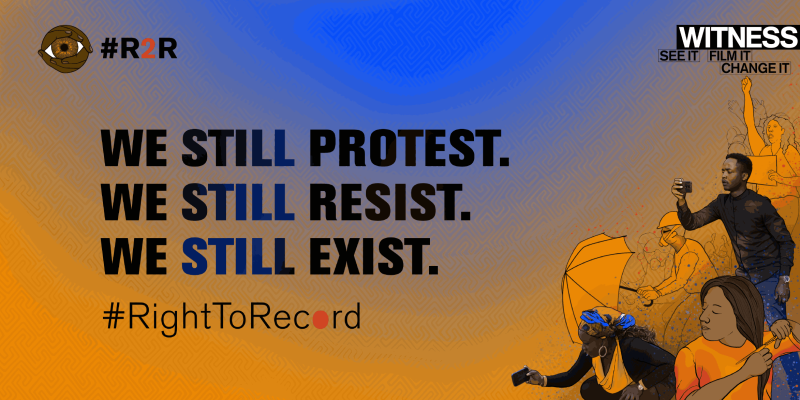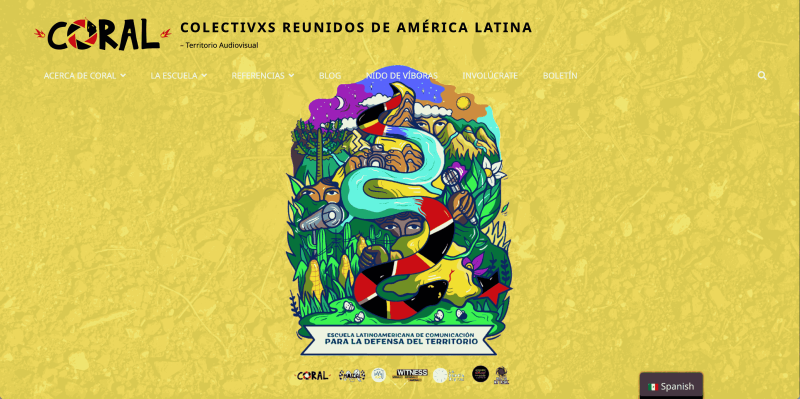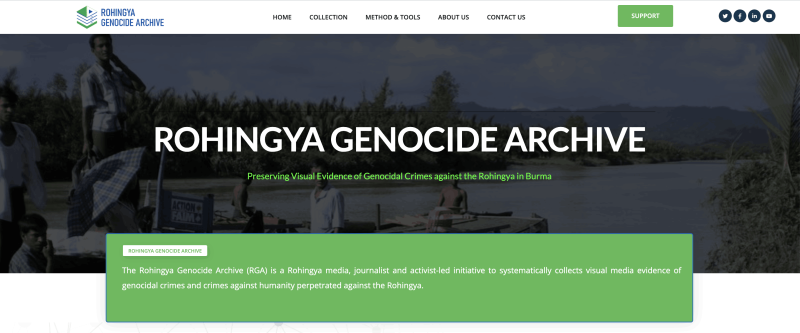Strengthening Community-Based Human Rights Video Witnessing
Yvonne Ng
→
(WITNESS)
This text is adapted from a talk I gave as part of a session on “Witnessing” at the Inward Outward Symposium on Witnessing/Care and the Archive in March 2023. Appropriate to the theme of the session and the symposium, I actually work at an organization called WITNESS. Our mission is to support people to use video and technol- ogy to protect and defend human rights. We are a nonprofit organization made up of over 50 people from many different walks of life based in about a dozen different countries. We are all connected to diverse communities and human rights movements across the globe.
Here is a photo of our team:

I am an audiovisual archivist, and I oversee WITNESS’s archives program. I am part of a team organized into six regional programs and three cross-regional thematic programs. We work directly and collaboratively with human rights defenders in all of our regions to support their advocacy goals. With our partners, we also learn and co-create guidance that we share and use to engage with the human rights community more broadly. In addition, we advocate to large video and technology companies to ensure that their tools and services support human rights rather than hinder and endanger the most marginalized.
For the Inward Outward session, I was invited to speak about our work and to reflect on the practice of witnessing as an embodied practice, and what that means in terms of how I approach archival work.
“When Is Archival Evidence of Colonial Violence Evidentiary Enough?”
The Inward Outward organizers gave us a prompt: “When is archival evidence of colonial violence evidentiary enough?” My response to that question is, unfortunately, that evidence often is not “evidentiary enough” in the context of achieving justice, accountability, or human rights change. That is, we live in a time that often offers more than enough audiovisual evidence of human rights violations for all of us to know what is happening. However, because of global power structures, having evidence—even lots of it—often does not in itself lead to change, unless such accounts are also deployed strategically to reach the people or institutions who can influence change—and, moreover, unless those people and institutions listen to, believe, and act on that evidence.
There is also the question of what is “enough” in terms of what the world asks of human rights documenters. Front Line Defenders publishes their annual Global Analysis, which tracks the number of human rights defenders killed each year. In 2022, it identified the killing of 401 human rights defenders in 26 countries. These numbers do not include the countless other human rights defenders targeted with surveillance and false charges, or who are attacked with smear campaigns for the work they do to defend their communities. Human rights documenters take on a huge burden and physical risk when they record video evidence of violations. The Inward Outward session description states that “Witnessing […] always combines the aural and the ocular.” In fact, human rights witnessing involves more than just the eyes and ears; it can implicate one’s entire body, one’s life. What lengths should documenters go to, and what lengths can we expect them to go to, to collect the evidence necessary to meet our increasing standards for reliability, especially in contexts where repressive regimes overtly target human rights defenders and clamp down on freedom of expression?
Who We Center, Serve, Support
In our work at WITNESS, we aim to center the people and communities most impacted by human rights violations, and to serve and work alongside local activists and experts who are using video and technology to advance human rights. To the participants at this symposium, this may seem an obvious and straightforward choice, but in many spheres it is not the common perspective. Consider, for example, the gaze implied in language like “user-generated content,” “open-source intelligence,” or “open-source investigation,” and the dehumanizing and disembodying effect of conceiving of documenters and documented people as “users” or “sources.” In addition to those we serve and support, our work also involves collaboration with others for support and solidarity, working together to ease the burdens and mitigate the risks to documenters.

Our orientation to documenters and communities is reflected in the image above, from our recent global digital engagement campaign on the Right to Record. For this campaign, we shared case studies, tip sheets, blog posts, and material from different regions to show solidarity with filmers around the world and to share information on how people can exercise their right to record safely and effectively.
Fortifying the Truth
One troubling trend that makes our mission more challenging is the rise of misinformation and disin- formation. Authoritarian regimes are increasingly attacking the truth, and new AI-enabled deep fakes and synthetic media are on the rise. As a result, the trust in visual evidence that underlies the notionof “evidentiary enough”—the idea that “seeing is believing”—is being undermined. In such a climate of misinformation, for example, the Nigerian fed- eral government and military were emboldened to reject the findings of a judicial panel of inquiry investigating police violence and killings during the 2020 EndSARS protests, claiming that videos showing people being hurt were faked (Onuah).
In a context where the truth of accounts of human rights abuses is under attack, we strive to honor the risks that documenters take, helping to ensure their videos have the most impact possible. A key theme in our current strategic vision is “Fortifying the Truth,” meaning that we aim to strengthen the credibility, integrity, and power of human rights defenders’ videos, to amplify their voices and narratives, and to help them to create trustworthy videos that can be used effectively. We approach this from multiple angles—by supporting activists with skills and capacity building, helping to develop new tactics that can be shared with the wider human rights community, and by influencing technology and infrastructure to support human rights.
To be clear, when I use the word “truth,” I do not mean it in the sense of cold impartiality or so-called “objectivity.” I invoke a conception of truth that emanates from embodied experience rather than as a technically defined outcome of procedure and distance. Lilie Chouliaraki and Mette Mortensen capture this idea well in the term “flesh witnessing.” In calling for a shift in how journalists perceive “user-generated content” (UGC) as just free-floating disembodied content, they argue that the concept of
flesh witnessing invites us to examine UGC in terms of its modes of address (who it speaks to and how), its acts of claim-making (what it is saying and to which end) and the moral and political communities it calls into existence (what kind of response it invites and from whom). (594)
In such an approach, the so-called users in user-generated content
can no longer be seen solely as impersonal producers of news narratives of violence, but become instead fully (or at least more) human—that is, they become social and political actors that aspire to intervene in global public spheres, communicate their predicament and speak their truth. (594)
Archive as a Verb
Just as this symposium speaks of deploying “witnessing” and “care” as verbs to highlight their sense of implication and activity, at WITNESS we also tend to use “archiving” or “archive” as a verb. Archiving, or caring for archives, is an act and a means to achieving other human rights goals, rather than an end in itself.
Our collaboration with Berkeley Copwatch, a volunteer-run organization in Berkeley, California, is an example of our archiving work. Berkeley Copwatch has been active for over 30 years and has pioneered approaches for the direct observation of police using cameras as part of their organization against police violence, injustice, and overreach. By documenting such incidents, they aim to keep the police accountable and to assert the rights of detained persons. They provide support to victims when possible, educate the public about their rights and about police conduct in the community, and organize to unite the community to resist police abuse.
We started working with Berkeley Copwatch in 2018. They had been collecting incident data and video for years by this point and had started thinking about how they could make better use of it. From our conversations, we learned that they wanted to use videos from their cop-watching shifts and videos from the community to identify patterns and repeated police misconduct, and to use in their campaign work. Over the course of many in-person workshops, work sessions, and calls, we collaborated on the design and build of a database to track videos, policing incidents, and the officers involved in these incidents, as well as a workflow to manage video files.
Walkthrough of the People’s Database for Community-Based Police Accountability.
By 2020, Berkeley Copwatch had incorporated the database into their workflow, entering and using it to pull up information and videos for use in campaigns. In the same year we also co-hosted workshops and one-on-one sessions to share our learnings with other cop-watch groups. We published the project documentation and a template of the Filemaker database for other groups to freely examine, adapt, and use (this template was recently updated based on learnings from Berkeley Copwatch usage in 2023).
However, making the template and documentation freely available has not been enough to enable many other groups to adopt the tool. Despite their stated interest and the limited support we could offer, there still appears to be a significant capacity barrier to getting started. We are keeping this replicability challenge in mind for future projects.

Looking Ahead
Looking ahead, our collaborative work to fortify the truth with communities impacted by human rights violations will take place within two main initiatives. One initiative focuses on protecting the Earth and supporting land defenders resisting extractive industries, displacement, and persecution, within the context of a long history of colonization and present-day capitalist, extractive, and hegemonic systems. In this work, we center indigenous peoples and young people, and their visions and solutions for the world that include the use of video. The initiative builds on the work our team has done over the last decade in Latin America, and it builds on movement strategies like freedom schools to create spaces for weaving resistance and coming together to formulate solutions. Through this framework, for example, our teams in Brazil and Latin America co-created an intergenerational network of audiovisual collectives called Coletivos Reunidos de America Latina, or CORAL. The project will build the capacity of the network and the movements of which they are a part through collaboration and by training trainers at convenings in the region.

The second initiative focuses on strengthening the knowledge, skills, and capacity of human rights defenders and communities in three fields of practice that are key to using video for justice and accountability—archiving, analysis and verification, and curation and presentation—and building stronger connections between frontline communities and distant witnesses who could provide more solidarity and support. This includes exploring ways to make approaches and tools in these subject areas (often developed in the Global North and within dominant communities of practice) more accessible and better suited to the financial, technological, infrastructural, security, linguistic, cultural, and other contexts of the rest of the world. It also involves helping to ensure frontline defenders are included in the development and setting of standards that reflect the realities of their contexts. To this end, we are working with grassroots partners such as the Rohingya Genocide Archive to support their capacity and develop practical new approaches. We will also work to connect our partners to relevant communities of practice and help make those communities of practice more aware and inclusive of the needs and innovations coming from grassroots human rights defenders.
In closing, witnessing as an embodied practice is a deeply human act that we approach with as much thoughtfulness, presence, and self-awareness as we can, and through which we continue to learn and evolve.